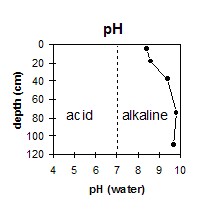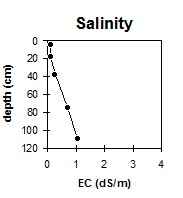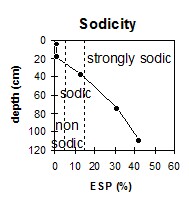MP13
| Location: Manangatang | General Landscape Description: Open depression within a swale. |
| Australian Soil Classification: Endohypersodic, Pedal, Hypercalcic, CALCAROSOL |
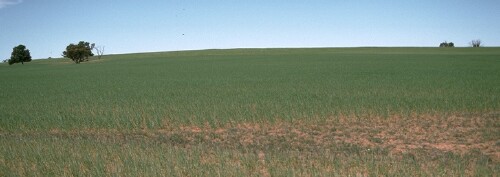 MP13 Landscape |
Soil Profile Morphology:
Surface Soil
| A11 (Ap) | 0-10 cm | Reddish brown (5YR3/4); fine sandy clay loam; massive; firm consistence dry; highly calcareous; pH 8.4; abrupt change to: | 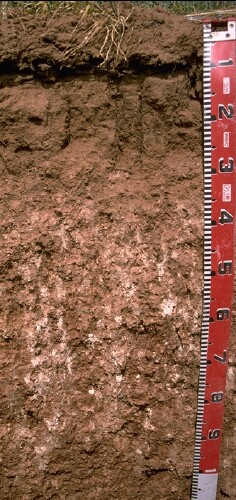 MP13 Profile |
| A12 | 10-25 cm | Strong brown (7.5YR4/6); clay loam; massive; strong consistence dry; plough pan developing between 10-12 cm depth; very highly calcareous; pH 8.6; clear change to: | |
| Subsoil | |||
| B21k | 25-50 cm | Strong brown (7.5YR4/6); light clay; moderate medium prismatic, parting to strong medium blocky structure; firm consistence dry; contains many (20-50%) soft carbonates; very highly calcareous; pH 9.4; gradual change to: | |
| B22k | 50-100 cm | Yellowish red (5YR5/6); medium clay; moderate coarse prismatic, parting to strong medium blocky structure; strong consistence dry; contains many (20-50%) soft carbonates; very highly calcareous; pH 9.8: | |
| B23 | 100+ cm | Yellowish red (5YR5/6); medium heavy clay; strong coarse prismatic, parting to strong medium blocky structure (smooth faced peds); very strong consistence dry; contains a few (2-10%) dark stains and very few (2%) soft carbonates; very highly calcareous; pH 9.7. | |
Key Profile Features:
- Lack of strong texture contrast between surface (A) and subsoil (B) horizons
- Strongly alkaline profile.
- High accumulation of carbonates in the subsoil.
- Subsoil becomes strongly sodic at 40 cm depth.
|
Management Considerations
Surface (A) Horizon
- The infiltration is high in the sandy surface horizon, however, it will slow down in the second surface horizon (A12) due to the increased clay content. A plough pan is also developing within the top few centimetres of this second horizon (A12). The rest of this second horizon has a very high calcium level which is beneficial for plant nutrition, as well as for aggregate stability. Of note is that, the majority of roots are in this surface area (0-25 cm).
- The surface soil is non-sodic, however, it does slightly disperse after remoulding. This indicates that tillage or over-stocking of the soil whilst in a moist to wet condition may result in structural degradation occurring (e.g. surface sealing, increased clodiness). Raindrop action on bare soil may have a similar effect, so it is important to maintain surface cover. Increasing organic matter levels will also help to improve these characteristics as well as assisting in soil aggregation. Gypsum application may assist in improving surface soil structural condition.
- The very strongly alkaline subsoil suggests that some nutrients (e.g. manganese, zinc, iron, copper) may be poorly available to plants.
- The coarsely structured subsoil becomes strongly sodic below 40 cm depth and has a very low exchangeable calcium to magnesium ratio (ie. 0.3 at 50 cm). Strong dispersion occurs as a result restricting root and water movement, however, with the increase of salt levels going down the profile the dispersion decreases. Deep ripping into the subsoil may help to break up the physical structural problems and the application of gypsum would help to neutralise the chemical sodic problems. This expensive option would firstly depend on expected crop yield and also on adequate rainfall, to wash the gypsum down the deep rips into the subsoil. Ripping should not take place when the soil to be disturbed is wetter than the plastic limit. Gypsum can also be added to the surface without deep ripping, but it would require more time to wash the gypsum down to the subsoil and less of it would probably make it (pers. com. Nabil Badawy).
- The salinity rating becomes moderate at about 80 cm. These levels of soluble salts are likely to restrict the growth of salt sensitive plant species (e.g. faba beans, linseed, chickpeas and lupins) especially those which are deep rooted.
- Surface forms into clods when cultivated wet.
- At the time of soil sampling this location was a trial site for wheat varieties.
Profile Described By: Mark Imhof and Sonia Thompson (October 1994)

